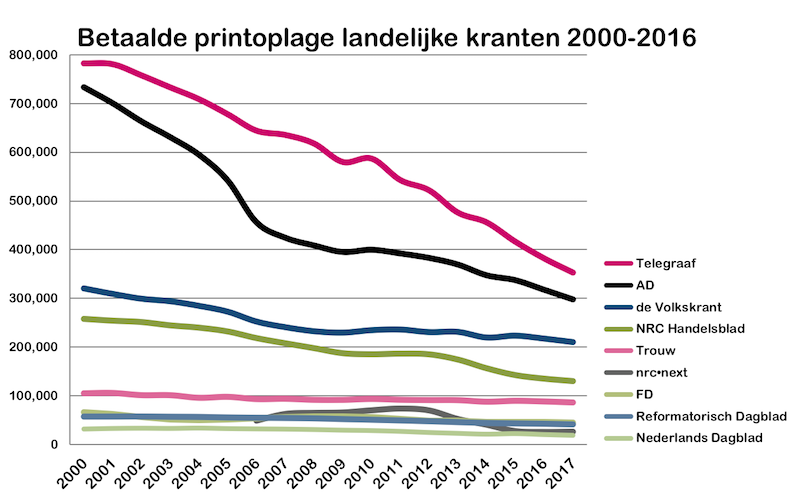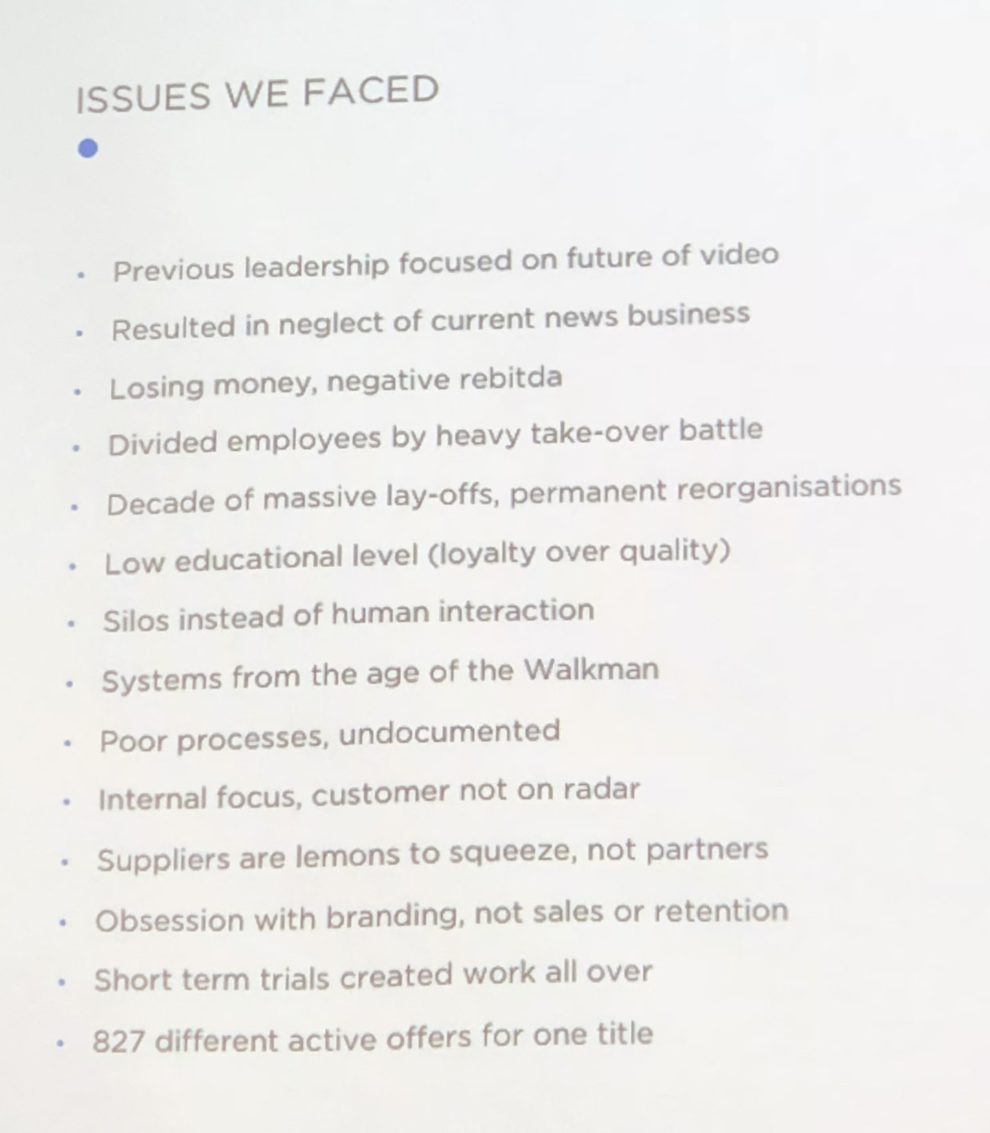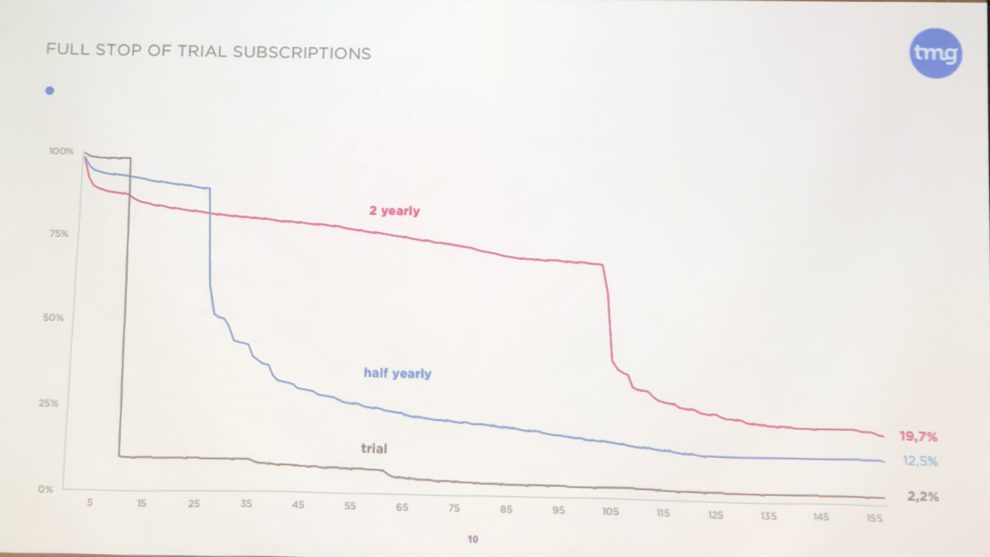Blog
How De Telegraaf turned around declining subscriptions revenues
During the recent INMA Innovation Study Tour in Amsterdam, we visited De Telegraaf. Marc Van Geel (CEO) and Xavier Van Leeuwe (Director Consumers) gave us an inside look into the recent and impressive turnaround. They took over the leadership of De Telegraaf mid 2017, after an intense takeover battle between Mediahuis and Talpa, which left the flagging publisher for many months in turmoil and distress.
50% loss of print circulation in 10 years
De Telegraaf has long been the most popular newspaper in the Netherlands. In 2000 the average newspaper circulation per edition was approximately 800.000 copies. By 2017 this had dropped to 353.000. De Telegraaf was not the only newspaper brand losing traction, but the decline was much faster than the other titles.

In 2017, after an intense take over battle with Talpa, the investment vehicle controlled by Dutch media tycoon John De Mol, the leading Belgian newspaper publishing group Mediahuis,* acquired a majority stake in De Telegraaf. A new CEO, Marc Van Geel, was appointed. He and his team prepared and communicated a plan for future development to the employees and stakeholders in November 2017. Focus was given on strong brands, customer orientation and more efficient organisation.
The issues faced by the new leadership team were tremendous. The operations were losing money, the previous management had put a big bet on video and systems dated from the age of the Walkman. Employee morale was at an all time low, partially also because of the takeover battle. De Telegraaf also had a history of lifelong employment.

Turnaround in about 6 months: 66% more subscriptions with 24% less marketing cost
Xavier Van Leeuwe joined De Telegraaf in October 2017 as Director Consumers. Previously he held a similar position at NRC, a quality newspaper in the Netherlands and also part of Mediahuis.
Xavier is a strong believer in establishing long term relations with readers and subscribers. With his former colleague Matthijs Van de Peppel, he co-authored the management book The Relationship Economy.
One of the first actions taken by his team was to simplify the product offering. Upon his joining, there were more than 800 product offers. He reduced it to less than 30.
Secondly, when analysing the churn rates of the subscriptions, it was very clear that short term subscriptions and trial subscriptions did not result in long term sustained relationships, while it cost a lot to the organization. On the other hand, the churn rate on long term subscriptions is significantly lower.

In a bold move, De Telegraaf stopped offering their short term subscriptions. Against more conventional wisdom and industry practices, they started offering long term subscriptions.
“Most publishers don’t dare to offer long term contracts, as they are afraid to scare off readers” – Xavier van Leeuwe, Director Consumers
This move has been particularly successful, resulting in a year-on-year subscriptions growth of 66%.

This growth has been achieved with a much lower marketing and acquisition budget (-24% vs 2017).

“Longer contracts build stronger relationships. Trials don’t.”
Earlier that morning, we also visited NRC Handelsblad, a quality newspaper in the Netherlands. Matthijs Van de Peppel, Director Marketing, has similar experience as De Telegraaf. Churn rate on a 2-years basis on short term autostop trial subscriptions was only 96%, whereas on longer term iPad subscriptions, churn rates are only 53% (on a 2-year basis).
NRC has also successfully introduce 3-years subscriptions, offering readers financial discounts, since having this insight.
Key lessons
- Keep it simple: reduce your offerings and simplify the choices for your readers.
- Visit your readers in their kitchen. Members of the various levels in the organization visited readers in their homes, and listen to their experiences. Following the concepts of Design Thinking, various improvements have been realized since.
- Focus on the core. Because of its size, De Telegraaf had invested in many different internet businesses. The new management team has divested a number of brands and put more focus on its core news brands.
- Focus on long term relationships, not on short term trials. ePapers, digital versions of the print editions, are excellent tools to hook and engage readers into longer term relationships.
Extra reading
Amsterdam study tour participants take deep dive in local media innovation
* Mediahuis is home to the following newspaper brands : Het Nieuwsblad, De Standaard, Gazet van Antwerpen, Het Belang van Limburg, De Limburger, NRC and De Telegraaf.
Other Blog Posts

Stay on top of the game
Subscribe to Twipe’s weekly newsletter to receive industry insights, case studies, and event invitations.
"(Required)" indicates required fields

